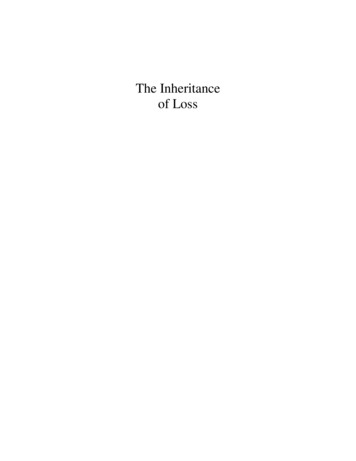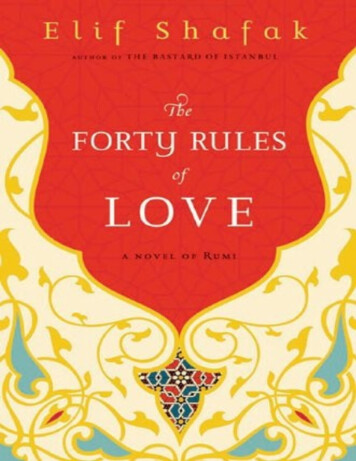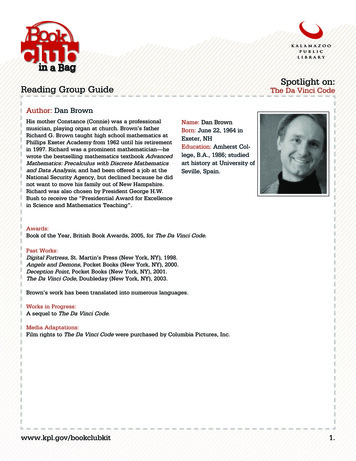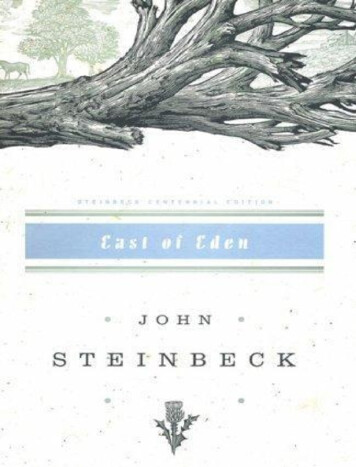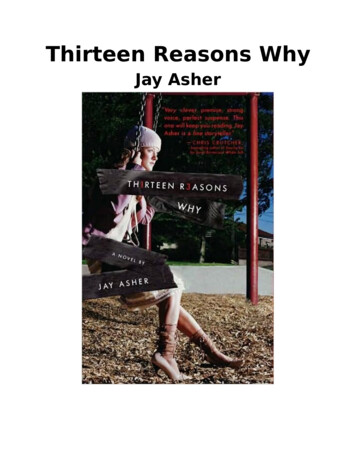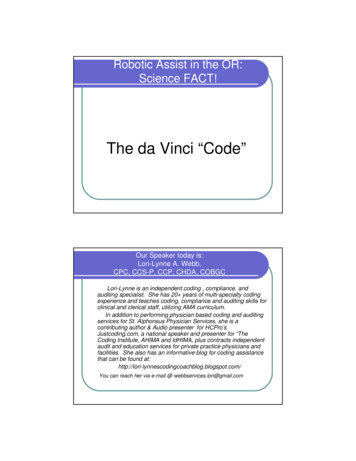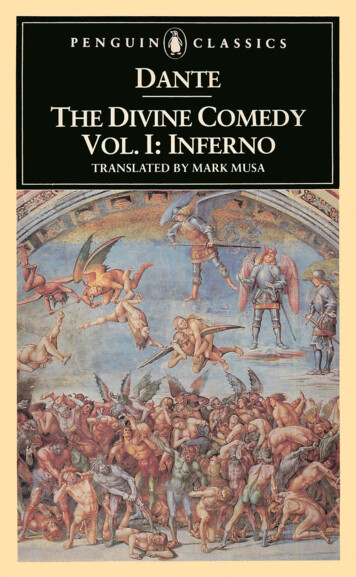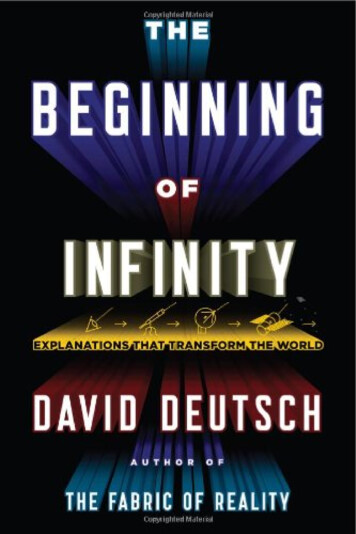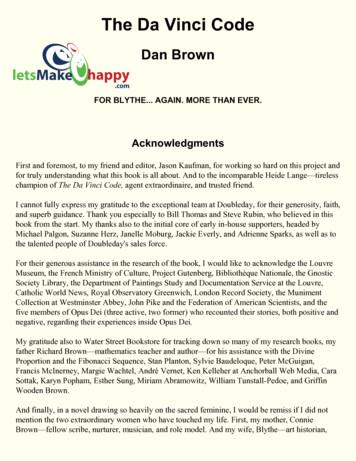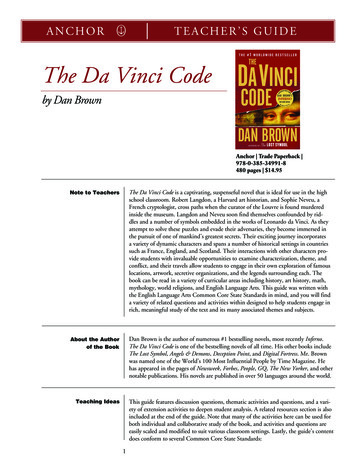
Transcription
ANCHORT eacher ’ s g u ideThe Da Vinci Codeby Dan BrownAnchor Trade Paperback 978-0-385-34991-8480 pages 14.95Note to TeachersThe Da Vinci Code is a captivating, suspenseful novel that is ideal for use in the highschool classroom. Robert Langdon, a Harvard art historian, and Sophie Neveu, aFrench cryptologist, cross paths when the curator of the Louvre is found murderedinside the museum. Langdon and Neveu soon find themselves confounded by riddles and a number of symbols embedded in the works of Leonardo da Vinci. As theyattempt to solve these puzzles and evade their adversaries, they become immersed inthe pursuit of one of mankind’s greatest secrets. Their exciting journey incorporatesa variety of dynamic characters and spans a number of historical settings in countriessuch as France, England, and Scotland. Their interactions with other characters provide students with invaluable opportunities to examine characterization, theme, andconflict, and their travels allow students to engage in their own exploration of famouslocations, artwork, secretive organizations, and the legends surrounding each. Thebook can be read in a variety of curricular areas including history, art history, math,mythology, world religions, and English Language Arts. This guide was written withthe English Language Arts Common Core State Standards in mind, and you will finda variety of related questions and activities within designed to help students engage inrich, meaningful study of the text and its many associated themes and subjects.About the Authorof the BookDan Brown is the author of numerous #1 bestselling novels, most recently Inferno.The Da Vinci Code is one of the bestselling novels of all time. His other books includeThe Lost Symbol, Angels & Demons, Deception Point, and Digital Fortress. Mr. Brownwas named one of the World’s 100 Most Influential People by Time Magazine. Hehas appeared in the pages of Newsweek, Forbes, People, GQ, The New Yorker, and othernotable publications. His novels are published in over 50 languages around the world.Teaching IdeasThis guide features discussion questions, thematic activities and questions, and a variety of extension activities to deepen student analysis. A related resources section is alsoincluded at the end of the guide. Note that many of the activities here can be used forboth individual and collaborative study of the book, and activities and questions areeasily scaled and modified to suit various classroom settings. Lastly, the guide’s contentdoes conform to several Common Core State Standards:1
CCSS.ELA-Literacy.RL.9-10.1Cite strong and thorough textual evidence to support analysis of what the text saysexplicitly as well as inferences drawn from the text.CCSS.ELA-Literacy.RL.9-10.2Determine a theme or central idea of a text and analyze in detail its development overthe course of the text, including how it emerges and is shaped and refined by specificdetails; provide an objective summary of text according to ze how complex characters (e.g., those with multiple or conflicting motivations)develop over the course of a text, interact with other characters, and advance the plotor develop the theme.CCSS.ELA-Literacy.RL.9-10.5Analyze how an author’s choices concerning how to structure a text, order eventswithin it (e.g., parallel plots), and manipulate time (e.g., pacing, flashbacks) create sucheffects as mystery, tension, or surprise.CCSS.ELA-Literacy.RL.9-10.7Analyze the representation of a subject or a key scene in two different artistic mediums,including what is emphasized or absent in each treatment (e.g., Auden’s “Musée desBeaux Arts” and Breughel’s Landscape with the Fall of Icarus).CCSS.ELA-Literacy.W.9-10.2Write informative/explanatory texts to examine and convey complex ideas, concepts,and information clearly and accurately through the effective selection, organization,and analysis of content.CCSS.ELA-Literacy.W.9-10.3Write narratives to develop real or imagined experiences or events using effective technique, well-chosen details, and well-structured event sequences.CCSS.ELA-Literacy.SL.9-10.5Make strategic use of digital media (e.g., textual, graphical, audio, visual, and interactive elements) in presentations to enhance understanding of findings, reasoning, andevidence and to add interest.This section includes a number of questions designed to provoke critical analysis.These questions can be posed to the entire class to generate discussion, or studentscould respond individually through writing, in paired conversations, in small groups, etc.Discussion and Writing QuestionsPrologue-Chapter 51. In what ways does the prologue create suspense and generate reader interest?2. “ Last month, much to Langdon’s embarrassment, Boston Magazine had listed himas one of that city’s top ten most intriguing people” (p. 8). What do you think hisembarrassment reveals about his character?3. On p. 12, how do Silas’ physical description, living quarters, and dialogue characterize him?4. Chapter Three references several famous French locations. What could the author’spurpose be for mentioning such well known locations?2
5. hat adjectives would you use to describe the conversation between Fache andWLangdon in Chapter Four? Why?6. ompare and contrast Bishop Aringarosa’s views of Opus Dei, as stated inCChapter Five, with those held by the media.Chapters 6–101. “ Saunière had drawn a simple symbol on his flesh—five straight lines that intersected to form a five-pointed star” (p. 35). What is the significance of this symbol?How does Langdon’s explanation of the pentacle contrast with popular culture’sview of it?2. How do Sister Sandrine’s thoughts regarding Opus Dei (p. 41) indirectly characterize Bishop Aringarosa?3. H ow do the passages in Chapter Eight regarding Leonardo da Vinci contribute tothe chapter’s overall mood and extend the scope of the narrative?4. “ She was moving down the corridor toward them with long, fluid strides a haunting certainty to her gait” (p. 50). Based on the ensuing physical description ofher and her initial interactions with Langdon and Fache, how would you describeSophie’s personality?5. W hy does the author include Silas’ backstory in Chapter 10? What effect does thishave on the reader?Chapters 11–151. “ This is the Fibonacci sequence,’ she declared, nodding toward the piece of paper inFache’s hand” (pp. 60–61). What exactly is this sequence? What additional information can you locate about it?2. How does Chapter 12 present a plot twist for both Robert Langdon and the reader?3. In Chapter 13, how does the information revealed during her conversation withLangdon give Sophie’s character increased depth?4. “ Not surprising, Collet thought. Fache needs this arrest desperately” (p. 71). Whydoes he “need” the arrest? Do you view Fache as a villainous character for pursuingLangdon? Why? Why not?5. D espite the pistol available to him, Silas does not bring it into the church (p. 73).How does this detail, and others, characterize Silas as a contradictory figure?Chapters 16–201. Explain the complex feelings Sophie has about her grandfather. Do you believe herfeelings are justified? Why? Why not?2. H ow does the mention of Sophie’s family’s death (p. 76) affect the reader’s perception of Sophie’s relationship with her grandfather?3. T ake a close look at the writing in Chapter 18. How do specific passages contributeto the section’s frenetic pacing and suspenseful mood?4. H ow do the events and dialogue in Chapter 19 create dramatic irony? Cite specificpassages in your explanation.5. “ As he moved, Langdon felt like he was trying to assemble a jigsaw puzzle in thedark” (p. 91). What does this mean? In what ways is this simile effective?6. What is the significance of PHI?3
Chapters 21–251. W hy do you think the author included the flashback of Sophie and her grandfather’s visit to the Mona Lisa in Chapter 21?2. W hat is the significance of Saint-Sulpice’s architectural layout (p. 105)? Why is theRose Line an important feature?3. W hat is the Priory of Sion? How does the group connect to both Leonardo daVinci and Sophie’s grandfather?4. “ You are not the only one with secrets, she thought” (p. 115). What does SisterSandrine’s thought mean?Chapter 26–301. W hy do you think the author includes abundant background information aboutthe Mona Lisa in Chapter 26?2. “ Sophie looked baffled in the glow of the message scrawled across the Mona Lisa’sface. SO DARK THE CON OF MAN” (p. 124). How exactly does this messagerefer to Langdon’s subsequent explanation?3. D espite his religious conviction, Silas removes his cloak and batters the floor of thechurch (p. 127). How do you imagine Silas justifies these actions to himself?4. “ Sophie realized that Leonardo da Vinci, for the second time tonight, was there tohelp” (p. 133). What is meant by this statement?Chapters 31–351. “ A sudden explosion of rage erupted behind the monk’s eyes. He lunged, lashingout with the candle stand like a club” (p. 136). Are you surprised by Silas’ viciousattack on Sister Sandrine? Why? Why not?2. “ The participants took a step inward and knelt. In that instant, Sophie could finallysee what they all were witnessing” (p. 143). What do you think Sophie observes here?3. H ow does the design of the key’s head differ from the “traditional long-stemmedChristian cross” (p. 145)? How do the different designs differ in a symbolic sense?4. What sort of issues does Bishop Aringarosa have with the Vatican?5. What does Langdon reveal on the back of the cross? Why could this be important?Chapters 36–401. S ummarize the history of the Priory of Sion. What sort of relationship did theyhave with the Knights Templar?2. What does the “story of the Sangreal” (p. 161) refer to?3. Explain the significance of the Holy Grail as both a physical object and a symbol.4. What does Leonardo da Vinci have to do with the search for the Holy Grail?Chapters 41–451. How does the setting of Castel Gandolfo contribute to the mood of Chapter 41?2. C ompare and contrast the architecture of the bank with that of several other locations mentioned thus far in the book.4
3. Why would Saunière use the Bank of Zurich?4. W hy does Vernet assist Sophie and Langdon? Do you think he has a hiddenagenda? Why? Why not?5. Describe the object that Langdon and Sophie retrieve from the bank.Chapters 46–501. H ow would you describe the relationship between Silas, the Teacher, and BishopAringarosa?2. I n Chapter 47, how does the author build suspense for the opening of the mysterious box?3. What exactly is a cryptex? Describe its characteristics and origin.4. What is the keystone, and why is it important to Langdon and Sophie?Chapters 51–551. “ Sophie wondered if finding out was worth her life” (p. 216). Do you think it is?Should Langdon and Sophie abandon this “grail quest”? Why? Why not?2. A s he did, an alluring whiff of Sophie’s perfume filled his nostrils, and he realizedhow close they were” (p. 220). Does this passage alter the reader’s view of Sophieand Langdon’s relationship?3. Upon first impression, how would you describe Teabing?4. In Chapter 55, how do Teabing’s statements about the Holy Grail contrast withpopular conceptions of it?5. “‘ The Bible did not arrive by fax from heaven’” (p. 231). What does Teabing meanby this statement?Chapters 56–601. I n Chapter 56, how does the inclusion of actual symbols in the text affect thenarrative?2. W hy is the chalice significant? How does it connect to other symbols mentionedthus far?3. “‘ As it turns out, the Holy Grail does indeed make an appearance in The LastSupper’” (pp. 242–43). What exactly is Langdon referring to here?4) What is a “scotoma” (p. 243)? How does it pertain to The Last Supper?5) W hat is the significance of Mary Magdalene? How does her existence, accordingto Langdon and Teabing, challenge traditional Christian doctrine?Chapters 61–651. W hat point is Langdon making by referencing Walt Disney’s films? What could bea reason for the author including this reference?2. A ccording to Teabing, why does the Church feel threatened by the Priory and theinformation they protect?3. “ Tonight has become the strangest and most magical night of my life” (p. 273).Why does Teabing think this?5
4. Why does Collet defy Fache’s orders to not enter Teabing’s estate?Chapters 66–701. T eabing, Langdon, and several other characters leave the estate. Where do theywish to go and why?2. “ Silas feared he had failed the Teacher and the bishop forever” (pp. 287–88).Why does Silas feel this way? Is it surprising to see Silas in such a disadvantageousposition? Why? Why not?3. W hat does the flashback at the start of Chapter 68 reveal about Langdon’s connection to Saunière?4. T eabing tells Sophie “you must either fully embrace this responsibility . . .or you must pass that responsibility to someone else” (p. 294). What do you believeSophie should do? Why?Chapters 71–751. A t the beginning of Chapter 71, the inscription under the box lid is printed on thepage for the reader to see. Why would the author include the actual text here?2. What is iambic pentameter? Why does it matter in this context?3. What exactly was the sex rite that Sophie witnessed?4. D oes Sophie’s flashback in Chapter 74 affect how you perceive her grandfather?Why? Why not?Chapters 76–801. Why is Sophie’s name significant?2. D escribe the mood of the first part of Chapter 78. How does the author establishthis mood?3. C ollet and his men find an old document in Teabing’s home? What is it and why isit important?Chapters 81–851. I n Chapter 81, how does Teabing deal with the chief inspector? What does thisreveal about his character?2. What could the poem on p. 337 allude to? Construct your own theories.3. “ The comment sounded more pragmatic than romantic, and yet Langdon felt anunexpected flicker of attraction between them” (p. 340). How does Langdon andSophie’s partnership continue to evolve?4. “ What do you think we should do with the Sangreal documents if we ever findthem?” (p. 341). What do you think they should do? Support your argument withspecific reasons.Chapters 86–901. “ Langdon raised the cryptex high over his head. ‘I will not hesitate to smash this onthe floor and break the vial inside’” (p. 358). Do you believe Langdon cares enoughabout Teabing and Sophie to go forward with this threat? Why? Why not?6
2. W hat do Collet and his men find back in Chateau Villette? What are the implications of this?3. Are you surprised by Fache’s admission of his mistake (p. 368)? Why? Why not?4. Who were the individuals being bugged? Why is this revelation important?Chapters 91–951. W hy is Silas intensely disappointed by the Teacher’s request that Remy deliver thekeystone to him?2. Who is being manipulated by the Teacher? Remy? Silas? Or both?3. What evidence of foreshadowing can you locate on p. 383?4. What happens to Remy? Was this expected or unexpected? Why?Chapters 96–1001. In the College Garden, how does the setting reflect the sacred feminine?2. How did Teabing capitalize on Saunière’s greatest fears?3. Given his actions in this latter section of the book, do you believe Teabing is thetrue villain in the story? Why? Why not?4. W hat does Aringarosa decide to do with his briefcase of money? Does this redeemhis character? Why? Why not?5. Who does Sophie meet during her visit to Rosslyn Chapel?6. “ With a sudden upwelling of reverence, Robert Langdon fell to his knees” (p. 454).What do you believe Langdon does with his knowledge of the grail’s location? Why?Exploring the ThemesThis section features a variety of questions and activities pertaining to five of the text’scentral themes.The Holy Grail1. “ The true nature of the Grail? Sophie felt even more lost now. . . . ‘The HolyGrail is the Cup of Christ,’ she said. ‘How much simpler could it be?’” (p. 162).Examine the text and explain how Teabing and Langdon challenge and expandSophie’s initial understanding of the Grail. What are the larger implications ofthese new revelations about the Grail? How could they challenge existing institutions and religious understandings?2. “ With a quiet smile Langdon pulled a piece of paper from the pocket of his tweedcoat and handed it to Faukman. The page listed a biography of over fifty titles—books by well-known historians, some contemporary, some centuries old—many ofthem academic bestsellers” (p. 163). Perform your own research and locate severaldifferent texts that explore the meaning and significance of the Grail. Share yourfindings with the class.3. “ The only certainty is that the hidden M is no mistake. Countless Grail-relatedworks contain the hidden letter M—whether as watermarks, underpaintings, orcompositional allusions” (p. 245). Research and locate artwork featuring the HolyGrail and/or its associated symbols, such as the letter M and the chalice, and shareyour findings with the class.7
4. E xamine various Grail quests in literature and film and compare/contrast themwith the quest for the Grail in The Da Vinci Code.The Sacred Feminine1. Throughout the book, Robert Langdon discusses how the sacred feminine hasbeen marginalized by various forces and groups throughout history. According tothe text, which factions are primarily behind this devaluing of the sacred feminine,and why do these groups perceive it as a threat?2. Go back through the text and locate several different symbols that represent thesacred feminine. While researching the historical significance of these symbols,create or locate digital representations of them (a Google Image search could locateimages, and http://slimber.com/ could be used to create them) and present them tothe class. Which symbols did you choose to locate? Why? How old are these symbols? What sort of meanings do they have? Have the meanings changed throughouttime? If so, how?3. I n Chapter 58, Langdon mentions the word “scotoma,” which is essentially a formof visual and cognitive blindness (p. 243). Consider the many female characters inthe book and examine how both the reader and other characters are blind to theirtrue identities and capabilities. Which female characters are undervalued? Whichaspects of their identities are concealed? Which preconceived notions conceal them?Unveil your findings to the class through an oral presentation.4. I n Chapter 61, Langdon explains how some Disney movies are infused with thesacred feminine (p. 261). Through your own symbologist lens, examine severalmainstream films, Disney-produced or otherwise, and identify allusions and metaphors related to the sacred feminine. Locate several specific film clips that you canshow and discuss with your classmates.5. H ow does Sophie’s actual name connect to the sacred feminine ideal? Also, in whatways could she be considered a heroine?The Meaning and Power of Symbols1. “ [U]sing his own blood as ink, and employing his own naked abdomen as a canvas,Saunière had drawn a simple symbol on his flesh” (p. 35). Examine the appearances,both literal and figurative, of blood in the text. How does blood function as a symbolin The Da Vinci Code?2. H ow do various characters in the text function as “symbols” with their own concealed truths? Use a simple T-Chart (located here: t eng.pdf ) to place the headings “Inner” and “Outer”on opposite sides in order to analyze one of the following characters and discuss thecontrast between his or her outer appearance and inner countenance: Bezu Fache,Leigh Teabing, Sophie Neveu, Bishop Aringarosa, or Jacques Saunière.3. T he Da Vinci Code focuses extensively on the ways in which artwork can featurepowerful symbols, but what other codes are present in the text? Consider both thelanguage-based and mathematical patterns/symbols mentioned in the novel anddiscuss their implications. What are other important symbols or patterns, consistingof letters or numbers, outside of the text that you can identify and analyze? Write ashort, coherent essay unpacking these questions.8
4. I n Chapter 61, Langdon explains that the arts served as “discreet channels . . .channels that supported metaphor and symbolism” (p. 261). Consider this statementand access the following resource: en-messages-art/. After reading the article and examining the included images,create your own artwork that contains at least two hidden symbols mentioned in TheDa Vinci Code, such as the chalice, pentacle, etc. Be prepared to present your artworkto the class.5. In what ways do the book’s many symbols and codes generate suspense, affectmood, and advance the plot of the novel? Choose specific examples and explain.6. A n archetype is a sort of universal symbol that can be found in many works of literature. These include character types, literal symbols, situations, and patterns. Searchfor evidence of several archetypes such as the hero, the villain, the mother figure,or the quest in The Da Vinci Code. What evidence can you find of their existence?Share your findings with your classmates.7. R esearch some of the mathematical concepts mentioned in the novel such as PHI,the Divine Proportion, and the Fibonacci sequence. What are these concepts? Whyare they important both in the novel and in the world?.The Subjectivity of History1. D uring his conversation with Sophie Neveu, Teabing states, “History is alwayswritten by the winners. When two cultures clash, the loser is obliterated, and thewinner writes the history books—books which glorify their own cause and disparage the conquered foe. . . . By its very nature, history is always a one-sided account”(p. 256). Do you agree or disagree with this statement? Why? Also, how isTeabing’s statement about history reflected in other parts of the book? 2. C onsider the many historical locations mentioned in the book. Choose a setting,such as King’s College, the Temple Church, Westminster Abbey, Rosslyn Chapel,etc., and perform outside research to examine its historical background and associated legends. Analyze how its background is discussed in The Da Vinci Code, andalso examine how various characters in the text, if applicable, supplement/alteryour chosen setting with new historical information. Finally, create a PowerPoint,Google Slides, or Prezi (http://www.prezi.com) presentation to share your findingswith the class.3. H ow do various characters in the book confirm, challenge, or complicate traditional religious ideas and tenets? Use a graphic organizer such as a Describing /wheel eng.pdf) to analyze howvarious characters interpret religious history and doctrine.4. D espite the book’s fictional status, a “Fact” page is included at the beginning of thebook. How does the information on this page affect the reader’s perception of therest of the novel?5. How does Sophie’s perception of her own history change throughout the book?The Significance of Religious Groups and Secretive Organizations1. S elect several main characters and trace how their individual narratives are shapedby, and intersect with, some of the religious organizations in the text. How do theVatican, Opus Dei, and the Priory affect and influence the main characters in TheDa Vinci Code?2. W hat are some of the rituals practiced by the various religious groups in the novel?What purposes do these rituals and practices have?9
3. S ecretive organizations mentioned in the book include the Priory of Sion, OpusDei, and the Knights Templar. Choose an organization and closely examine itsdepiction in The Da Vinci Code from the perspective of an investigative reporter.While drawing on applicable passages from the text, design a website for yourchosen organization that reports on its central mission, details its history, providesinformation about related characters in the novel, and includes other pertinentinformation. Each website must contain text, images, and video. Google Sites (allGoogle resources mentioned in this guide are available with a free Google account),http://www.weebly.com, or http://www.wix.com are all free resources that can beused for this activity.4. L angdon exclaims, “The Priory believes that Constantine and his male successors successfully converted the world from matriarchal paganism to patriarchalChristianity by waging a campaign of propaganda that demonized the sacred feminine.” (p. 124). According to the text, how did the Priory, and specific memberssuch as Leonardo da Vinci, promote the sacred feminine and push back againstpatriarchal Christianity? Cite specific passages as you formulate your response.5. H ow do Bishop Aringarosa, Silas, Opus Dei, and the Vatican interpretCatholicism? Compare and contrast the religious viewpoints of these differentcharacters and organizations.6. E xamine the practice of corporal mortification. Analyze how it is portrayed inthe book and how groups such as Opus Dei view and utilize it in reality.Extension ActivitiesThis section includes activities/projects that are designed to extend student analysis ofthe novel. Note that many of these can be used in either individual or grouped configurations. Also, while many of the activities here are primarily designed for use afterstudents finish the book, several activities can be used during reading as well.1. Student Generated Questions (QAR)Allow students to take ownership of inquiry through this activity. QAR refers toQuestion-Answer Relationships: Right there questions: answers to these questions are found explicitlyin the text.Think and search questions: the answer lies in the text, but it may onlybe found by examining several different sections and piecing it together.Author and you: answers connect the text and personal experience.On my own: answers do not require text; personal experience is privileged.Have students work independently to generate one question, per category, for a specific section of the book (Teabing, Langdon, and Sophie’s conversation inside ChateauVillette, Langdon’s experiences in the Louvre, or any later chapter in the book wouldwork well for this). Tell students to record their questions on a separate sheet of paper.After these questions are generated, teachers have several options: ave students submit questions on notecards, and randomly select several forHa quick assessment. Have students trade and answer each other’s questions in writing or throughpaired conversation. Have students select one question to expand upon in an extended, writtenresponse (“Right there” questions do not work well for this).For more information on this strategy, consult this l10
2. Character Study through Concept MapsA Concept Map allows students to display their analysis in an organized, visualmanner. This graphic organizer works particularly well with The Da Vinci Codeas the book features many dynamic character relationships. Concept Maps can beused in several different ways. First, students can select one character to occupy thecenter of the map, and linked sections can specify character traits along with textual support. Second, students can feature two characters, one on each side of thediagram, and they can list similar and contrasting characteristics on different sides.Lastly, students can feature multiple characters within the same map, and linkedsections of the map can identify how each character truly views yet outwardlybehaves toward the other (linking Teabing to Langdon would highlight the discrepancy between Teabing’s true intentions and his contrived, outward behavior). For examples of these maps, consult this resource: http://tinyurl.com/concmaps For a simple online Concept Map creator, go earch/conceptMap.html3. Open Mind Symbology ActivityIn this activity, students select a character and make inferences about what resideswithin his or her mind. Have small groups of students select a character and construct a list of his or her personality traits, fears, goals, desires, and other notablecharacteristics. Next, have students represent these things visually through symbols(for example, one symbol for Langdon might be a magnifying glass, to symbolizehis curiosity and propensity for close examination).Once they have several symbols, have students cut out (or create on a digital canvas) a profile of their character’s head and arrange the symbols inside. Students canuse traditional art supplies (construction paper, markers, magazines, etc) or digitalresources such as http://www.queeky.com/app. On the back, or underneath thecharacter profile, have students explain the reasoning for their symbols, and requirethem to cite specific text from the novel as justification. Have them present theirvisual project to the class.4. Paideia DiscussionA Paideia Seminar is a student-centered, Socratic discussion. In it, the teacher servesas facilitator by providing students with open-ended questions, prompting studentsto respond, and by linking student comments. There are three main question categories: opening questions, core questions, and closing questions. Opening questionsidentify main ideas from the text (Why is Leonardo da Vinci featured in the book’stitle?). Core questions require students to analyze textual details (In what specificways are Langdon and Sophie alike and different? How do specific settings impactthe book’s mood and affect reader interest?). Finally, closing questions personalizetextual concepts (What sort of lessons can be learned from the book? How do youexplain the book’s immense popularity?). Construct multiple questions like these,and have students gather in a large circle.Establish group goals for the discussion and have students create individualgoals as well. Some group goals could include practicing active listening strategies,disagreeing c
The Da Vinci Code is a captivating, suspenseful novel that is ideal for use in the high school classroom. Robert Langdon, a Harvard art historian, and Sophie Neveu, a French cryptologist, cross paths when the curator of the Louvre is found murdered inside the museum. Langdon and Neveu soon find themselves confounded by rid-


